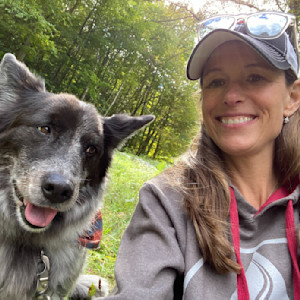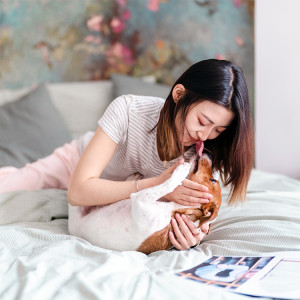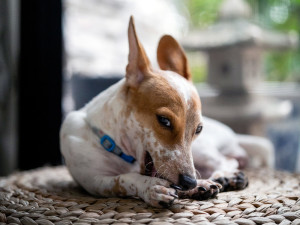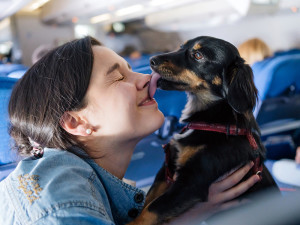
Share Article
In This Article:
Why Does My Dog Try To Lick My Wounds? Concern for You Instinct Wound Cleaning Frequently Asked Questions
On July 7, an 83-year-old woman in the United Kingdom died from a sepsis infection opens in new tab caused from a dog licking a wound on her body. June Baxter, a retired legal secretary, cut her leg while alone at home in late June; when her granddaughter (her caretaker) arrived with her dog, the pup licked the cut. Later, when Baxter was hospitalized, tests showed Pasteurella multocida, a type of bacteria typically found in dogs’ mouths.
This sad story leads to one central question: Why do dogs lick your cuts or wounds? For dogs, this is an affectionate behavior expressing their concern and desire to clean your wound so it heals better.
Why does my dog try to lick my wounds?
As pack animals, dogs lick each other’s wounds. Since dogs consider us, their caregivers and companions, part of their pack, it makes sense that they try to lick us, too. My rescue dog Lilac is a licker. Particularly in warm weather when bare legs display cuts and scrapes, she’s prone to licking. Her littermate Willy, on the other hand, rarely tries to lick anyone in the family (which I admit we appreciate).

Pet parents often wonder, Why does my dog lick my cuts? They may find this behavior odd or even off-putting, for good reason. While some research indicates dog saliva has antiseptic properties, there’s also harmful bacteria in your dog’s mouth that can transmit diseases and lead to infections. For that reason, it’s not advisable to let them to lick your cuts or wounds.
Amber Batteiger, a veterinary nurse and animal welfare expert at Embrace Pet Insuranceopens in new tab, says dogs’ impulse to lick our wounds is a mix of instinct and emotional connection. “The instinct is rooted in their natural drive to clean injuries, but it can also reflect their bond with you,” she says.
That doesn’t mean they should, though. “Dogs saliva carries bacteria like Pasteurella and Capnocytophaga, which can cause serious infections in humans, especially if the wound is deep or the person is immunocompromised,” Batteiger says. “Pet parents should discourage the behavior and keep their wounds cleaned and covered.”
Concern for you
When Lilac tries to lick a cut or a wound on one of my kids (who find this kind of gross), I tell them it’s her way of being a concerned dog. Dogs do feel empathy — it’s one of their many superpowers — and they pick up on physical and emotional distress.
Qiai Chong, founder of Pet Coach Singaporeopens in new tab, launched Singapore’s first canine behavior rehabilitation facility with her partner, Webster Cheong, and now works to raise awareness of animal welfare in Singapore. Per her website, she’s Singapore’s first dog behaviorist with a master’s degree in applied animal behavior and animal welfare from the University of Edinburgh. She says ascribing concern or emotional support to a dog’s licking isn’t entirely accurate. “It might feel like your dog is trying to comfort you when they lick a cut or scrape — but the truth is a little different,” she says.
Dogs have an acute sense of smell that picks up on the secretions and volatile organic compounds (VOCs) wounds emit. Think of your dog’s response to dirty laundry and smelly feet. They’re attentive to a wound because it’s something new to sniff and lick.
“Licking is one of the ways dogs explore and make sense of their environment, so in many cases, they’re simply curious,” Chong says. “To be clear, dogs can understand many human gestures and emotions, they’re incredibly perceptive animals and often respond to our tone of voice, body language, and mood. But when it comes to licking a wound, the motivation is more sensory than emotional. They’re responding to the scent, texture, and novelty of the injury, not trying to comfort or heal you in the way we might wish to believe.”
Instinct
Just like we might instinctively rub our elbow when we bump it hard on a doorframe, dogs instinctively lick wounds — yours or theirs. Rubbing and licking provides temporary relief from the pain signals the damaged nerve ending in a wound are sending to the brain. Licking also removes dirt from a wound. One reason dogs lick their paws when they come inside is to remove dirt and debris. As wounds heal and become itchy, dogs may want to lick them even more.
“It’s a self-soothing behavior that’s deeply rooted in how they instinctively respond to pain or irritation,” Chong says. “Their saliva contains mild antibacterial compounds, which might offer temporary relief, but it’s not a reliable or safe form of wound care.”
Why do dogs lick their wounds?
It’s clear dogs shouldn’t lick our wounds, but should they lick their own wounds? “Dogs cleaning and licking their own wounds is a deeply ingrained instinct,” Batteiger says. “Although it can potentially provide temporary relief by removing dirt or debris and soothing discomfort, excessive licking could delay healing, cause irritation, or lead to infection and worsening the injury. So although the behavior is instinctual and natural, it should be monitored.”
Clean your dog’s minor wounds with gentle soap and water. Never use ointment like Neosporin or another topical without consulting your vet as dogs can lick it off and become sick. Stay alert to excessive licking as it can lead to infection and skin diseases.
Batteiger and Chong recommend gently redirecting your dog’s attention from the wound with toys, treats or affection. Elizabethan collars (aka cones) are used after surgeries like neutering or spaying to physically block your dog from reaching the wound. For more serious injuries, fitted body suitsopens in new tab (also called recovery suits) and pet shirts prevent access to the wound without limiting movement.
“Personally, when I’m around and actively monitoring, I let my dog roam freely without a body suit or cone. If I see them trying to lick, I can quickly interrupt the behavior and reward them for stopping,” Chong says. “But the challenge comes when I’m not able to keep an eye on them. That’s when I put the cone or suit on just to be safe and to prevent any setbacks in healing. It balances comfort and care, and optimizes their recovery.”
Wound cleaning
The Egyptians, the ancient Greeks and even some contemporary cultures believe dog saliva kills harmful bacteria. Studies have been conducted to both prove the healing power of dog saliva and demonstrate its harmfulness.
While it’s clear dogs’ instinct and concern makes them want to lick our wounds, it’s not advised. As a behaviorist, Chong suggests erring on the side of caution. “I personally avoid introducing foreign substances to any open wound, including a dog’s saliva. If you have a fresh cut or scrape, it’s best to clean it properly and speak to your doctor if you’re unsure,” she says.
FAQs
What do I do if my dog has a wound they won’t stop licking?
For minor wounds, redirection and positive reinforcement are effective. Gently guide your dog away from the wound and reward them when they leave it alone. For serious injuries, cones and body suits limit access to a dog’s wound without inhibiting movement.
When should I visit a veterinarian because my dog is licking their own wound?
Call the vet any time your dog is seriously injured. Wounds may require stitches and antibiotics to promote healing. To prevent your dog from excessively licking and reopening a wound, your veterinarian can prescribe numbing gel and pain medications. Cones and recovery suits prevent access to injuries.
Is it bad for dogs to lick their own wounds?
For a short time, no, especially if it’s a minor surface wound. But excessive licking can aggravate a minor wound and make it bleed or become infected. It can also re-open a more serious wound and prevent it from healing.
References
“Can Dogs Smell Cancer in Humans? Research and Diagnosis.” www.medicalnewstoday.com, www.medicalnewstoday.com/articles/323620opens in new tab.
Cuffel, Grace. “Does Dog Saliva Have Healing Powers? | SiOWfa15: Science in Our World: Certainty and Controversy.” Psu.edu, 21 Oct. 2015, sites.psu.edu/siowfa15/2015/10/21/does-dog-saliva-have-healing-powers/opens in new tab.
“Dog Saliva: The next Wonder Drug? | Geophysical Institute.” Www.gi.alaska.edu, www.gi.alaska.edu/alaska-science-forum/dog-saliva-next-wonder-drugopens in new tab.
Jeter, Sarah. “Why Do Dogs Smell Open Wounds - Wag!” Wagwalking.com, Wag!, 2 Mar. 2018, wagwalking.com/behavior/why-do-dogs-smell-open-woundsopens in new tab. Accessed 31 July 2025.
“Keeping You and Your Dog from Sharing Diseases.” Health.osu.edu, 30 Nov. 2023, health.osu.edu/health/virus-and-infection/diseases-dogs-can-pass-to-humansopens in new tab.
Morandi, Evi M, et al. “A Small “Lick” Will Sink a Great Ship: Fulminant Septicaemia after Dog Saliva Wound Treatment in an Asplenic Patient.” International Wound Journal, vol. 14, no. 6, 19 Apr. 2017, pp. 1025–1028, https://doi.org/10.1111/iwj.12752opens in new tab.
“Simple Steps for Avoiding Infections from Dogs and Cats.” Harvard Health, 6 Apr. 2012, www.health.harvard.edu/blog/simple-steps-for-avoiding-infections-from-dogs-and-cats-201204064577opens in new tab.
Suttie, Jill. “Does Your Dog Have Empathy for You?” Greater Good, 2017, greatergood.berkeley.edu/article/item/does_your_dog_have_empathy_for_youopens in new tab.
Szánthó, Flóra, et al. “Is Your Dog Empathic? Developing a Dog Emotional Reactivity Survey.” PLOS ONE, vol. 12, no. 2, 13 Feb. 2017, p. e0170397, https://doi.org/10.1371/journal.pone.0170397opens in new tab.

Catherine Fahy Green
Catherine Fahy Green is a journalist turned copy and content writer. As a pets writer, she focuses on and is fascinated by animal body language because there's so much to learn from and about animals by spending time in their presence and observing their physical cues.
Her work as a PR specialist appears in national trade media as press releases and stories about exciting new products people should try. She lives with her family in Western Massachusetts, where she listens closely to the stories her two dogs, flock of chickens, and four horses tell her. She spends her weekends at horse shows with her daughter.
Related articles
![A Terrier Puppy With Spots And Big Ears Chews On Their Paws.]()
Why Do Dogs Chew Their Paws?
And when will it stop?
![Small black and white dog licking itself.]()
Why Do Dogs Lick Themselves?
They especially love to do this when they’re ignoring you.
Why Does My Dog Lick Me? The Meaning Behind Dogs Licking Us
The sentiment is nice, but...
Why Does My Dog Lick the Floor?
How does that taste, bud?
Why Does Your Dog Lick Your Other Dog’s Ears?
That’s cute... sort of?
Why Would Your Dog Lick Your Ears? 7 Common Reasons Why
It could be affection, a sign of stress, or just your dog being your dog.







